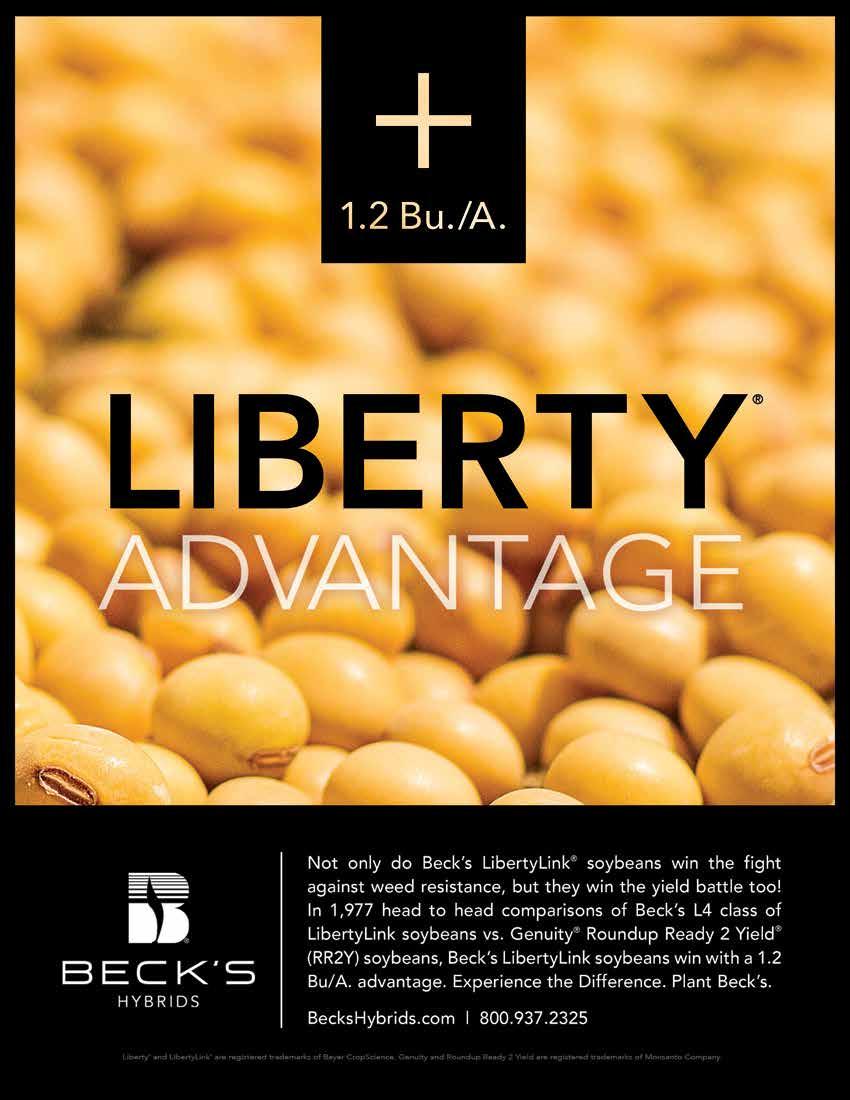

Ohio Soybean News


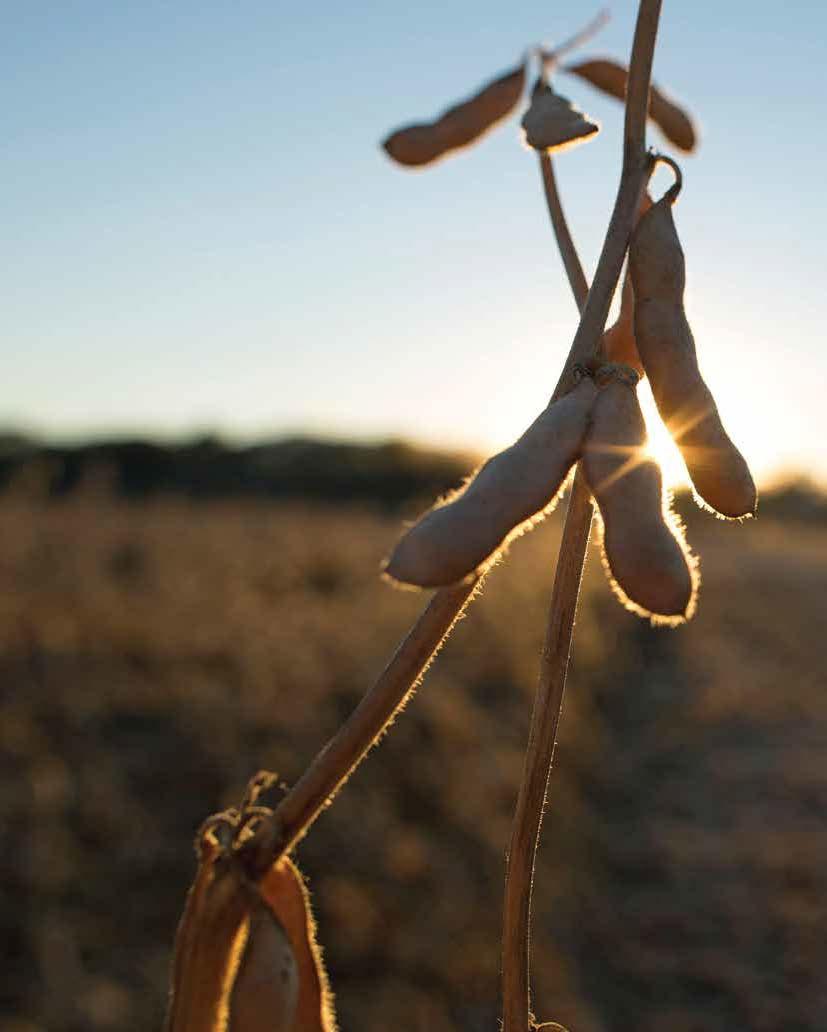
Creating Value for Ohio Soybeans

Emc² of Columbus, Ohio invests in soy-based technology


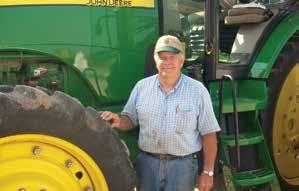




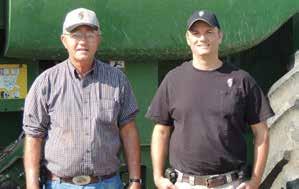
Tom Flora – Delphi, Indiana
Kaffenbarger Farms – New Carlisle, Ohio
Ohio Soybean News
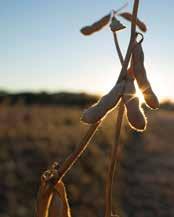




Perspective
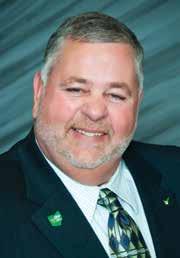
Bret Davis
Ohio Soybean Association Chairman Delaware County soybean farmer
A Letter From the Chairman
Hello, Spring!!
e planting process
got o to a later start than usual in certain parts of the state. As I write this in Delaware County during early May, we have seen some cold and rainy days but the elds did dry out and planting has begun!
is issue of Ohio Soybean News includes several informative articles relating to both the Ohio Soybean Association (OSA) and Ohio Soybean Council. is issue also contains information on great opportunities that you can take advantage of in 2014. Some examples include: the 2014 Ohio Soybean Yield and Quality Contest, Beck’s Young Farm Leader Program, Succession Planning Workshops, Ohio State Fair and a chance to sign-up for OSA’s new Policy Connection e-newsletter.
On the legislative news front, new legislation was introduced to establish a federal voluntary labeling standard for foods made with genetically modi ed organisms, or GMOs. OSA fully supports Federal legislation to establish voluntary labeling standards for the presence or absence of GMOs in food products and prevent inconsistent state labeling laws.
e Safe and Accurate Food Labeling Act would:
• Direct FDA to provide guidance for companies that wish to label their products for the presence or absence of GMOs
• Officially, make mandatory an FDA safety review of all new GMO traits before they are brought to market and enable FDA to mandate labels on any product shown to pose a health, safety or nutrition risk
• Direct the FDA to define the term “natural” for use on food labels
Remember to check out all the opportunities for the upcoming year and visit www.soyohio.org for additional news and information on the Ohio soybean industry.
Hope you have a safe and productive planting season.

President
SOYBEAN ASSOCIATION
Jerry Bambauer, Auglaize County
Chairman
Bret Davis, Delaware County
First Vice President
Tom Price, Putnam County
Vice President
Mike He el nger, Van Wert County
Treasurer
Je Roehm, Highland County
Secretary
Adam Graham, Logan County
Trustees
Allen Armstrong, Clark County
John Buck, Marion County
Amy Sigg Davis, Warren County
Dave Dotterer, Wayne County
Caitlyn Heimerl, Licking County
James Heimerl, Licking County
Todd Hesterman, Henry County
Chad McIlvaine, Ross County
Lane Osswald, Preble County
Bruce Simmons, Medina County
Bob Slicker, Stark County
Je Sollars, Fayette County
Industry Af liates
Kathy Alvarez, Bunge N.A.
Bill Tom, Trupointe Cooperative
American Soybean Association Board
Representatives
Bret Davis
Jerry Bambauer
Je Sollars
Staff Credits
Adam Ward – Publisher
Jennifer Coleman – Editor
Katie Bauer – Sta Writer
Judy Brent – Production Manager
Carol Locker – Designer
Ohio Soybean News is published six times a year by the Ohio Soybean Association, 918 Proprietors Rd., Suite A, Worthington, OH 43085 Phone: 614-476-3100. For address corrections contact Ohio Soybean News at 918 Proprietors Road, Suite A, Worthington, Ohio 43085. Web address: www.soyohio.org E-mail: cdeboard@soyohio.org

Comments and statewide news articles should be sent to the above address. Advertising space reservations must be made by the rst of the month preceding publication. In consideration of the acceptance of advertisement, the agency and the advertiser must, in respect of the contents of the advertisement, indemnify and save the publisher harmless against any expense arising from claims or actions against the publisher because of the publication of the content of the advertisement.
For Advertising Information Call: Tom Shearing
Advertising Sales Manager Phone: 585-476-2426






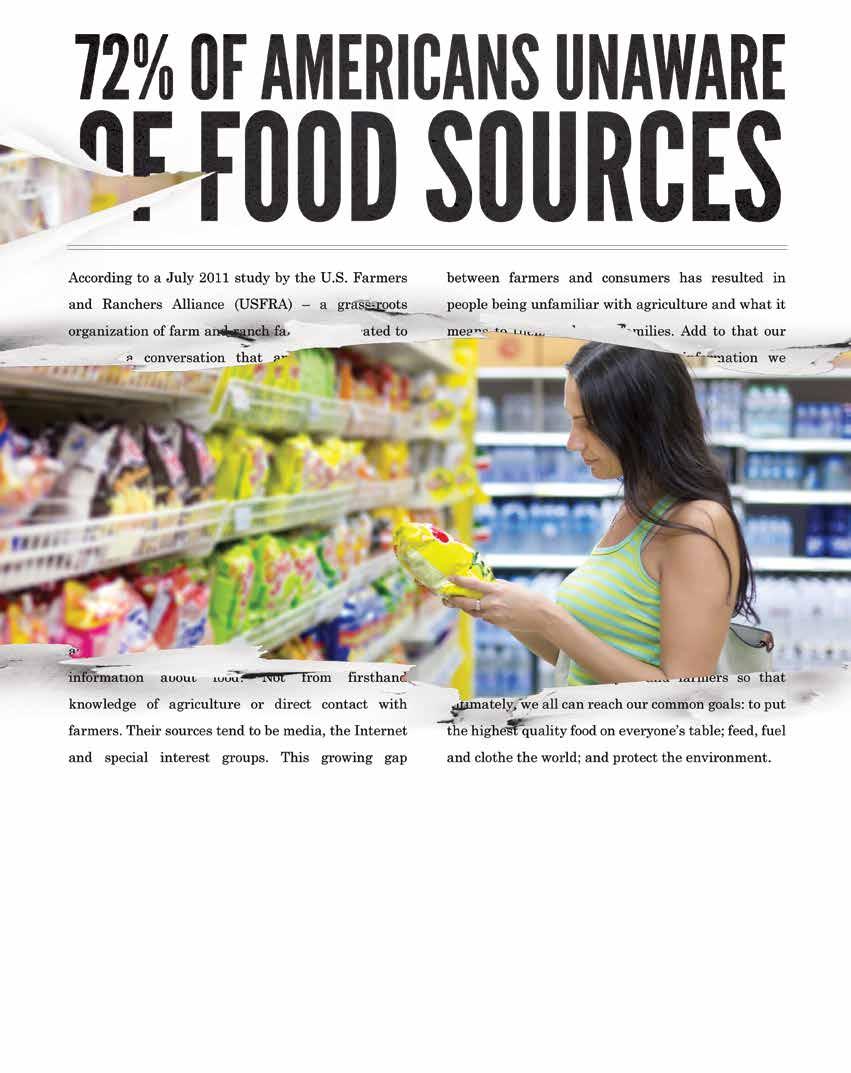
This message brought to you by Ohio soybean farmers and their checkoff.
©2013, Ohio Soybean Council


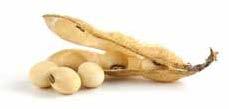
By Katie Bauer
T2014 Ohio Soybean Yield and Quality Contest

he Ohio Soybean Association (OSA) recently announced the launch of the state’s h Soybean Yield and Quality Contest for the 2014 growing season. Contestants must be current members of OSA and raise at least 10 acres of soybeans in Ohio. ose who are not currently OSA members may join when entering the contest. e entry fee is $100 and entrants may submit multiple entries.
e following seed companies have agreed to pay the entry fee for their varieties entered: Beck’s Hybrids, CROPLAN, LG Seeds, R Farm Seeds, Rupp Seeds, Seed Consultants, Shur Grow, Stine Seed Company and all
Monsanto varieties including, but not limited to, Asgrow, Channel and Stewart Seeds.
Entrants can choose to enter one or more of four categories that include:
• conventional tillage
• no-till
• non-GMO soybeans — conventional tillage
• non-GMO soybeans — no-till Developed to promote the importance of oil and protein, the quality contest is optional to enter. However, a farmer must enter the soybean yield contest in order to enter the soybean quality contest. is contest is based on the overall highest percentage of oil and protein content in the state. Entrants in the quality contest must submit a two-

I WILL KNOW MY WEEDS.
I will take action against herbicide-resistant weeds.

I will know my weeds. When they grow, when they pollinate, and I will stop them before they go to seed.

I will know their strengths, and I will exploit their weaknesses.
Troublesome weeds won’t go down without a fight. Neither will I. Because it’s worth the trouble.
Now is the time to take action against herbicide-resistant weeds. Visit www.TakeActionOnWeeds.com to learn about the most troublesome weeds.

pound sample of soybeans for testing. Entrants will be eligible for several prizes. An overall state yield winner will be awarded along with category prizes for the top placing entrants. Awards will also be given to the top placing entrants in the quality contest based on the percentages of oil and protein. All prize packages will be announced mid-September at www.soyohio.org/yieldcontest.
All entry forms and entry fees must be received by August 29, 2014. e entry form along with a complete listing of contest rules can be downloaded at www.soyohio.org/yieldcontest.
Additional sponsors of the 2014 Soybean Yield and Quality Contest include: Ohio AgNet, Ohio’s Country Journal and Ohio Soybean Council. u
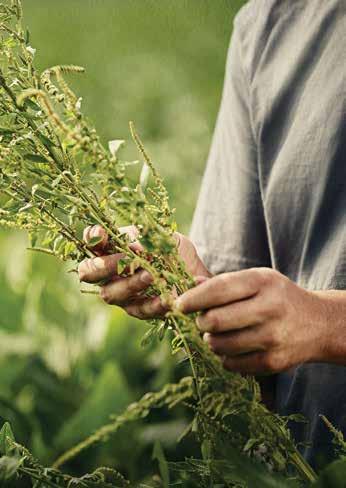
ENTRY FORM
2014 Ohio Soybean Yield and Quality Contest
This form must be completed in full and signed. Please read the 2014 Contest Rules before filling out this form. If you have any questions, call the Ohio Soybean Association office at 614-476-3100. Entry form and contest rules also available at www.soyohio.org/yieldcontest.
Please type or print legibly.
Name _______________________________________________________________________________________________
Address ____________________________________________________________________________________________
City ______________________________________________State _____________________Zip ____________________
Phone _________________________________County of Field Location _________________________________________
Ohio Soybean Association Membership # ___________________________________________________________________
Soybean Variety Name and/or Number ____________________________________________________________________
Planting Date _________________________________________________________________________________________



Category of Entry: Yield Only Yield & Quality


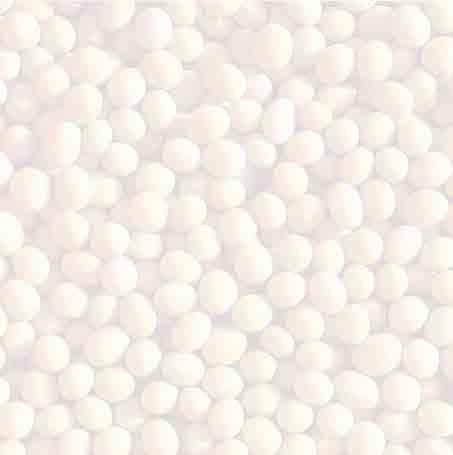

Conventional tillage No-till Non-GMO conventional tillage Non-GMO no-till
Seeds planted per acre _____________Row spacing ________________Soil type _________________________________
Requested contest officials (refer to #2 in the rules section for a list of suggested officials):
Official’s Name _____________________________________________Title ______________________________________
Company/Organization ________________________________________________________________________________
Address ___________________________________________________________________________________________
City ______________________________State ________Zip _____________ Phone ___________________________

I hereby certify the information provided on this Entry Form to be accurate to the best of my knowledge and agree all contest information shall become the property of the Ohio Soybean Association and can be used at the discretion of the Ohio Soybean Association.
Signature of applicant ___________________________________________ Date
Entry fee: $100 - Make check payable to the Ohio Soybean Association
• Each entrant will be granted a one-year membership to the Ohio Soybean Association. If you are currently a member, your membership will be extended for one year. If you wish to waive the membership grant, check here.
• If you have multiple entries, each additional entry will go toward a one-year endowment to a member of FFA or an individual in an agricultural field of study in an Ohio college or university.
Entry deadline: Postmarked by August 29, 2014
Submit this form along with your entry fee to: Ohio Soybean Association Yield Contest - 918 Proprietors Road, Suite A, Worthington, Ohio 43085
Questions? Call or email Adam Ward at 614-476-3100 or award@soyohio.org
SOYBEAN ASSOCIATION


Building Membership and Grassroots Advocacy
OSA Farmer-leaders Travel to Washington, D.C.
By Katie Bauer
Farmer leaders of the Ohio Soybean Association (OSA) recently traveled to Washington, D.C to meet
It’s no secret that soybeans are very sensitive to climate conditions. This is especially true in the pre-flowering and post-flowering stages, which cause inconsistent yields from year to year.
Utilize® has been proven to:
• Boost plant performance during the vital reproductive stage.
• Reduce climate impact on yield.
• Achieve more consistent yields.
with lawmakers and regulators on critical soybean industry issues including the recently passed farm bill, the Renewable Fuel Standard, waterways bills now in conference, trade, regulatory, biotechnol-

Thanks to its low use rate and ease of application, Utilize® makes the process simple.
Ready to shield your yield?
Contact your dealer or local Helena® representative to see how Utilize® can help you get the most from every soybean acre.
UtilizeBenefits.com


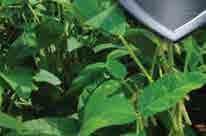





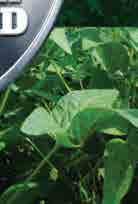
From le to right: Allen Armstrong, Jerry Bambauer, Je Sollars, Lane Osswald, Tom Price, Mike He el nger and Bret Davis, all OSA board members, spent time on Capitol hill lobbying on behalf of Ohio soybean farmers.
ogy, sustainability and aquaculture.
Eight members of OSA lobbied on behalf of Ohio Soybean farmers during visits. Representatives included: Bret Davis (Delaware County), Allen Armstrong (Clark County), Je Sollars (Fayette County), Adam Graham (Logan County), Jerry Bambauer (Auglaize County), Tom Price (Putnam County), Mike He el nger (Van Wert County) and Lane Osswald (Preble County).
“As a group, we were able to meet with several members of Ohio’s congressional delegation to discuss important issues facing the soybean industry,” said Adam Graham, OSA board member and soybean farmer from Logan County. “There is no substitute for face-to-face communication and Hill visits are a great way to build relationships with our lawmakers.”
While in Washington, D.C., Davis, Sollars and Bambauer participated in the American Soybean Association (ASA) board meeting. More than 100 soybean farmers, including the 43 members of ASA’s board met to discuss the policy victories and challenges facing the soybean industry in the near and long terms.
ASA also presented Senate Agriculture Committee Chairwoman Debbie Stabenow (D-Mich.) with the Soy Champion Award for her outstanding leadership and advocacy on behalf of soybean farmers. Chairwoman Stabenow played an instrumental role in the battle over the farm bill and has been a driving force for progress on risk management, biobased products, renewable fuels, trade, agricultural research, conservation and many other issues that impact soybean farmers’ success. u


Ohio Soybean Association Recognizes Brown and Gibbs as Legislators of the Year

By Jennifer Coleman
The Ohio Soybean Association (OSA) recently recognized Sen. Sherrod Brown (D-OH) and Rep. Bob Gibbs (R-OH) as OSA Legislators of the Year. OSA awards this distinction to a legislator or legislators who have shown a tremendous contribution to the success of the Ohio soybean industry.
Brown and Gibbs both played critical roles in the passage of the farm bill in early 2014 as both men served on their respective chambers’ Agriculture Committee. anks to their work, Ohio soybean farmers’ priorities were front and center in the new bill.
“As agriculture is only one percent of the U.S. population, it is more important than ever to cultivate the relationships
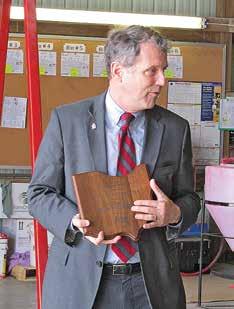
we have with the legislative leaders who understand farmers’ contribution to U.S. citizens and the economy,” said Jerry Bambauer, OSA president and Auglaize County soybean farmer. “I want to thank Sen. Brown and Rep. Gibbs for recognizing that contribution and working so hard on behalf of Ohio’s 24,000 soybean farmers.”
During the farm bill process, Brown partnered with Chairwoman Debbie Stabenow (D-MI) to be the leading voices of support for the Agriculture Risk Coverage program, supported by OSA.
OSA farmer leaders presented the award to Brown during a special event and meeting at the farm of Bret Davis, OSA chairman and Delaware County soybean farmer.
“With one in seven jobs related to food and agriculture in Ohio, it’s crucial that Ohio farmers have the resources they need while saving taxpayers’ money,” said Sen. Sherrod Brown. “This farm bill achieved that balance and the members of the Ohio Soybean Association helped to push this bill across the nish line. Representing Ohio farmers is an honor and I thank the Ohio Soybean Association for its recognition as legislator of the year.”
Brown and Gibbs have both been very accessible to soybean farmers and held multiple conference calls with leaders across the state. ey supported expanded funding of the Biobased Marketing Program and the continuation of the Renewable Fuel Standard, which includes a required level of use of biodiesel, the only advanced biofuels currently available on the market.Gibbs was officially presented this award in
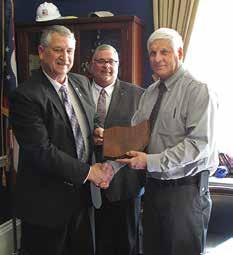
March during OSA’s visit to his office on Capitol Hill.
“I am honored to receive Legislator of the Year from the Ohio Soybean Association,” said Rep. Bob Gibbs. “OSA was critical throughout the development of a market-driven farm bill that would ensure American consumers would continue to have an abundant, safe and a ordable food supply. Ohio’s farmers are a key driver of our economy and job creation and I am grateful for all they do every day to produce wholesome food for all Americans.”
In addition to the farm bill, Brown and Gibbs currently support the passage of the Water Resources Development Act, which will help ensure farmers’ ability to get their product to both domestic and international markets. Without the nal passage of this legislation, U.S. infrastructure will continue to decay. u
Jerry Bambauer, OSA president (le ) and Bret Davis, OSA chairman (center) present Rep. Bob Gibbs (right) with the OSA Legislator of the Year award in Washington, D.C.
Sen. Sherrod speaks to a group of Ohio farmers at Bret Davis’ farm a er accepting his award as OSA Legislator of the Year.


Building Membership and Grassroots Advocacy
ASA Helps WISHH Partners Launch New African and Hispanic Foods Containing U.S. Soy
By Karen Edwards
April was Soyfoods Month in the United States but the excitement for new foods containing soy goes far beyond U.S. borders. e American Soybean Association’s (ASA) support for World Initiative for Soy in Human Health (WISHH) Program work has helped companies and groups in developing countries introduce nutritious and delicious Hispanic and African soyfoods in 2013-2014.
Examples include three soy-based Amelia cream soups launched by Guatemalan food company Alimentos Sociedad Anonima (Alimentos SA) in March. Ugandan food maker SESACO Ltd. has introduced SoySip, a just-addhot-water beverage that comes with packets of ginger and sugar. Multiple companies are extending meat products, ranging from beef to sh nuggets, with soy.
“WISHH introduces the benefits of soy and then trains developing country companies and organizations that are eager to add U.S. soy protein to their foods,” said Bret Davis, Ohio Soybean Association (OSA) Chairman and soybean farmer from Delaware County who serves on the WISHH committee as an ASA representative. “The teamwork creates new markets for all, and helps local consumers have healthier diets.”
“We are seeing a bumper crop of new foods containing soy o ered by companies and groups that WISHH has assisted through training, product samples and more,” said WISHH Chairman David
Iverson, a South Dakota soybean grower. “Soybean checkoffs, the U.S. Departments of Agriculture (USDA) and Agency for International Development (USAID) are assisting WISHH and its partners to help meet the enormous need for protein in nutritious foods that are also a ordable and available for developing country diets.”
anks to USDA Foreign Agricultural Service support, WISHH’s many spring 2014 activities included hosting educational conferences in Kenya and Ghana. At these programs, African and U.S. food industry as well as government participants explored opportunities in school feeding and retail programs to o er healthier foods.
WISHH’s USAID-supported work in Liberia is also an example of how production of new soy-based foods creates jobs, including for women, and makes much-needed protein available to local diets. Under the USAID-HANDS program, WISHH and Opportunities Industrialization Centers International have built two processing facilities where women manufacture forti ed-blended “Super Gari” cereal made with local cassava. Adding U.S. defatted soy our helps ll the protein gap that was in the traditional gari.
U.S. and developing country diets share common ground in that protein is needed for good health. e majority of U.S. consumers (78 percent) agree that protein contributes to a healthy diet and more than half of adults say they want more of it in their diets, reported the NPD Group in a study released in March.
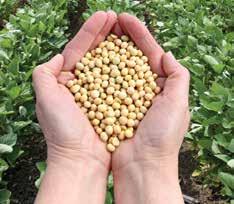
“WISHH introduces the bene ts of soy and then trains developing country companies and organizations that are eager to add U.S. soy protein to their foods,” said Bret Davis, OSA Chairman and soybean farmer from Delaware County. “ e teamwork creates new markets for all, and helps local consumers have healthier diets.”
Global protein ingredient market revenues are expected to reach USD 28.90 billion by 2020, according to a new study by Grand View Research. Plant proteins— led by soy — accounted for over 56% of global volumes in 2013, and are expected to continue dominating the market over the next six years, growing at an estimated compound annual growth rate of 6.3% from 2014 to 2020. Soy-based ingredients accounted for more than 70 percent of global volumes in 2013.
In addition to OSA, the Ohio Soybean Council (OSC) is among several state soybean checko boards that provide nancial support to WISHH. As a result, OSC board member Keith Roberts of Marion County sits on the WISHH committee and helps to shape the organizations strategic approach. u


Register Now for ASA Succession Planning Workshops
Planning for your farm’s future, or succession planning, is more than just creating a will. If you want to transfer your farm to the next generation, they’ll need the right leadership and business management skills to ensure nancial security. Now you can learn more about how to successfully transition your farm and protect your legacy at the ASA Succession Planning Workshops.
e American Soybean Association (ASA), in partnership with eLegacyConnect, will hold a series of six regional succession planning workshops to help farmers in this process. e Succession Planning Workshops, titled “Five Keys to Effective Succession Planning” are sponsored by Farm Credit, AGCO, Illinois Soybean Association, Kentucky Soybean Association Michigan Soybean Association and the Ohio Soybean Association.
“ASA is dedicated to enhancing and
protecting the livelihoods of soybean producers. Today’s tax laws and regulatory landscape are making it harder to keep the farm in the family,” said Bob Worth, ASA membership and corporate relations chairman. “Succession planning is a watershed issue facing all soybean producers and these workshops will provide soybean producers with the basics in getting a succession plan started.”
Workshops are taught by Kevin Spa ord, founder of Legacy by Design, a rm dedicated to succession planning for farm families and agribusiness owners. Over the last 10 years, he’s spearheaded initiatives to improve the way farmers, ranchers and agribusiness owners engage in the succession planning process.
For more information about these workshops visit the ASA website at www. soygrowers.com. u

I WILL USE MULTIPLE HERBICIDE SITES OF ACTION.
I will take action against herbicide-resistant weeds.

2014 Workshop Dates / Locations
June 24 Memphis, Tenn. The University of Memphis/University Center Ballroom A-B
June 26 Paducah, Ky. Julian Carroll Convention Center
July 30 Sioux Falls, S.D. Sioux Falls Convention Center
Aug. 19 Columbus, Ohio
Renaissance Columbus Downtown
Aug. 21 Fort Wayne, Ind. The Landmark Centre
Dec. 4 Moline, Ill. Stoney Creek Hotel and Conference Center
Each workshop begins at 9 a.m. and concludes by 3 p.m. Lunch is provided.
Registration Information Register online by going to www. soygrowers.com and selecting the location you want to attend. There is a minimal registration fee for each attendee. ASA members are $50 for first registrant and $30 for each additional family member/guest. Non-ASA members are $90 for first attendee and $70 for each additional family member/guest.

I will defend my crops with careful herbicide management. And I will use multiple herbicide sites of action because every action counts.
I will take action before weeds outgrow control. I will apply the right herbicide at the right rate at the right time.
I will take action. This time, for all time.
Now is the time to take action against herbicide-resistant weeds. Visit www.TakeActionOnWeeds.com to learn how you can preserve herbicide technology.




Get Connected to the Issues that Matter Most
Ohio soybean farmers regularly report that regulatory policy and legislative issues are top of mind when they think about the future success of their farms. Staying up-to-date on these issues and other industry trends will keep you ahead of the competition and better prepared for the future.
With that in mind, the Ohio Soybean Association (OSA) is proud to introduce the OSA Policy Connection e-newsletter, an exclusive bene t for OSA members only.
OSA Policy Connection will provide bill action alerts, industry news, regulatory updates, meeting and event schedules and much more — directly to your email.
To sign up, just visit www.soyohio.org/connection or ll out and mail the attached form. Don’t worry — OSA will never share or sell your personal information.
e OSA Policy Connection
e mission of OSA is to provide leadership for Ohio soybean farmers by promoting e ective policies and legislation to ensure a growing and pro table soybean industry.
To accomplish our mission, OSA farmer leaders work hard to stay on top of bill movement, regulatory rules and other changes to policy that are moving through our state and federal government. And when something comes up that will affect your bottom line, we’re there in the offices of your legislators to ensure your voice is heard.
But we can’t do this alone. Ohio soybean checko dollars cannot legally be used for lobbying activities, so your OSA membership is vital to the continued work that we do. Membership dues and your ability to mobilize when needed and call your legislators is critical in the legislative process.
If you are getting the Ohio Soybean News magazine, it doesn’t necessarily mean you are automatically an OSA member. If you would like to be an OSA member and enjoy bene ts like the OSA Policy Connection e-newsletter, visit www.soyohio.org/membership.
anks to the new OSA Policy Connection e-newsletter, you can stay connected to those issues that matter most to you and your farm. So take a minute and sign up!

Sincerely,

Jerry Bambauer OSA President








Auglaize County soybean farmer


Apply or Nominate Someone for the Beck’s Young Farm Leader Program
The Ohio Soybean Association (OSA) and Beck’s Hybrids share the belief that building a grassroots network of young agricultural leaders is important to the continued success of the soybean industry and all of Ohio agriculture. For this reason, OSA and Beck’s Hybrids have partnered to create the Beck’s Young Farm Leader Program to showcase the hard work, dedication and leadership of young Ohio farmers.
One farmer each quarter will be chosen by a selection committee consisting of OSA and Beck’s Hybrids representatives. Each farmer selected will be highlighted in a story published in several Ohio agricultural publications. The stories will focus on the individual’s leadership roles, both on and off the farm, and how he or she has built a foundation for farming success.
One of the Beck’s Young Farm Leaders will be selected as the 2014 Beck’s
Guidelines:
Farmers must be between the ages of 21 and 45
Any soybean farmer may apply for the Beck’s Young Leader Program; selected participants are required to have a current Ohio Soybean Association membership.
Applicants are not required to grow Beck’s Hybrids products to be eligible to win.
Applicants should demonstrate an interest in pursuing leadership roles within the soybean industry.
Young Farm Leader of the Year and receive a trip for two ($2,000 value) to the 2015 Commodity Classic in Phoenix, Arizona. Beck’s Young Farm Leaders may also be chosen to attend OSA and/or Beck’s Hybrids leadership
All applications postmarked by the following dates will be considered. Applications will carry over to subsequent quarters for consideration, but will not carry over to the 2015 Beck’s Young Farm Leader Program.
August 1, 2014: 3rd Quarter Applications Due October 31, 2014: 4th Quarter Applications Due Submit aplication by mail to: Ohio Soybean Association Beck’s Young Farm Leader Program 918 Proprietors Road, Suite A Worthington, Ohio 43085
INTERESTED IN NOMINATING
SOMEONE? Contact Adam Ward at award@soyohio.org or 614-476-3100. training programs, board meetings, events and other relevant activities.
Frogeye Should Be on Your Radar
Recently, soybean researchers from Kentucky, Indiana, Illinois and many states in the southern U.S. that border the Mississippi River reported the presence of the fungus Cercospora sojina that is resistant to the strobilurin fungicides. This fungus causes frogeye leaf spot on soybeans.
“To date, we have not identified any Cercospora sojina isolates from locations in Ohio that are insensitive to these fungicides,” commented Anne Dorrance, professor from The Ohio State University. “More monitoring will take place in 2014,” she continued.
an answer within 48 hours. They will let you know if the strobilurin fungicides will still be effective or if you will need to consider a triazole compound.

Samples were taken in Ohio last year, and it was found that this fungus is not as widespread here. However, if farmers think they have frogeye, they should send it to the lab immediately and researchers can have
“We have had a hard winter and most farmers practice good rotation with their field crops and plant varieties that are resistant to frogeye, so they shouldn’t be too concerned, but it is still a good idea for farmers to be on the lookout,” said Dorrance. “If it is caught early, we can advise farmers on what to do,” concluded Dorrance.
Managed by the Ohio Soybean Council and soybean checkoff, the Soybean Rewards Program helps Ohio soybean farmers increase productivity, yield and profitability by providing information and research related to premium opportunities, new varieties, disease and pest management and conservation practices.



Investing Checkoff Dollars
On the Hunt for Kudzu Bugs in Ohio
By Andy Michel, e Ohio State University Extension, Ohio Agricultural Research and Development Center
In 2009, the Kudzu bug was rst spotted near Atlanta, Georgia. Since then it has spread up the Atlantic Coast to Maryland, and westward across the Mississippi into Louisiana. ankfully, it has not reached Ohio yet, but was found in southern Kentucky in 2013. is is a serious invasive pest of soybean, and has presented numerous challenges to soybean producers in the Southeast, causing an average of 18% yield loss as well as numerous insecticide applications. Its importance and rapid spread might also cause problems for Ohio soybean producers once it arrives.
e Kudzu bug is a small, brown insect related to stink bugs and native to Asia. Adults overwinter near kudzu, wisteria or even homes, and then emerge in the spring around April or May. Normally, it will search and feed on kudzu, the invasive weed that is more prevalent in the south, but this plant is also known to occur in southern Ohio near the Ohio River. A er egg laying and nymphal development into adults, this new generation will disperse to soybean—adults are usually found in the late V stages. e nymphs of the kudzu bug are the most damaging, and these can be found in the early reproductive stages. Kudzu bugs will most likely be found on the stem, and are easily seen by direct observation or by sweep net collecting. Like soybean aphids or stink bugs they have piercing/sucking mouthparts, and their direct feeding contributes to yield loss.
is year, researchers from the Ohio Agricultural Research and Development Center, along with e Ohio State University (OSU) Extension Educators will be actively scouting and monitoring for this pest, with support from the Ohio Soybean Council (OSC) and soybean checko . We will be placing PVC kudzu bug traps (developed by Virginia Tech University) in
counties along the Ohio River. ese traps are white in color (kudzu bugs seem to like the color white) and have sticky paper wrapped around them to hold them until trap cooperators check the traps. We are also going to place traps along the I-75 corridor. Part of the reason why the kudzu bug has spread so rapidly is because it is a very good hitchhiker with vehicles. I-75 runs right through the heart of kudzu bug country, which may be a potential way they can invade Ohio. Since it is not known to occur in Ohio, our best strategy at this point is to survey and monitor likely areas of invasion. Soybean growers should inspect their elds this year for
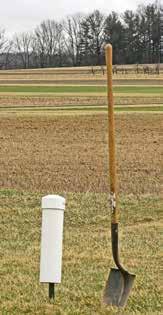
PVC kudzu bug traps are white in color and have sticky paper to hold them until trap cooperators check the traps.
the presence of kudzu bugs, especially those in Southern Ohio. If kudzu patches are also nearby, these should be scouted as well in late spring, early summer. If you think you have found kudzu bug, please contact Dr. Andy Michel (michel.70@ osu.edu) or your local OSU Extension office. Thankfully, soybean checko supported research has led to management recommendations to limit yield loss—but let’s hope we do not get to that point. For more information, including a soybean management guide, please see kudzubug.org. u
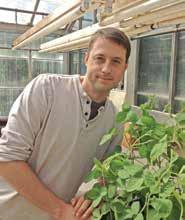

About the Researcher
Dr. Andy Michel’s research focuses on characterizing the genetic basis for insect adaptation and how these adaptive traits spread across the landscape. His overall goal is to understand how insect pests adapt to rapidly changing selection pressures in agroecosystems, such as host-shi ing to important crops or resistance to management tactics. Understanding and demonstrating how insects adapt, as well as communicating research-based insect management recommendations, delays the evolution of resistance or the emergence of pests and ensures a safer and more productive food supply. He received his BS in entomology from Purdue University (2001) and his Ph.D. in biology from the University of Notre Dame (2005). A er postdoctoral research also at Notre Dame (2005-2007), he joined the Department of Entomology at the Ohio Agricultural Research and Development Center at e Ohio State University with research and extension appointments in eld crops entomology. He has focused much of his research on the soybean aphid, Aphis glycines, but has also investigated adaptation in corn pests, such as western bean cutworm and western corn rootworm. Overall, he has received over $2 million in research funding and has published more than 35 peer-reviewed papers and two book chapters. Additionally, he has provided over 70 extension presentations on eld crop insect management, including the use of biotechnology and insect resistant crops.



Investing Checkoff Dollars
Creating Value for Ohio Soybeans Engineering Mechanics Corporation of Columbus, Ohio invests in soy-based technology
By Katie Bauer
Aer Ohio soybean farmer Keith Roberts unloads his soybeans at the elevator he o en re ects on where they will be going next.
“Ohio soybeans offer an abundant and renewable supply of ingredients for food and livestock feed,” said Roberts, Marion County soybean farmer and Chair of the Ohio Soybean Council’s (OSC) New Uses Committee. “In addition, soybeans make it possible for companies to reduce the petroleum content in commercial and industrial products by using soybean meal, oil or hulls in a variety of applications.”
One goal of the OSC and soybean checko program is to make known the expanding universe of soy-based products, and to make it easier for consumers to purchase them. OSC continually supports research to ensure new soy-based products are commercialized and sold in the market.
In the past two years, OSC has partnered with Engineering Mechanics Corporation of Columbus (Emc²) to establish the feasibility of using soybean hulls to replace a portion of the petroleum-based polymer resin used in many industrial and consumer applications without sacri cing performance. is material is known as Soy-based Advanced Natural Fiber Composite (S-ANFC) and incorporates soybean hulls as llers and reinforcements for plastic parts while maintaining a competitive price and performance that will increase soybean demand for consumer and industrial products.
“Replacing a significant portion of the petroleum-based polymer with soybean hulls produces a compound with strength and exibility properties on par with a 100% petroleum-based polymer compound,” said Dr. Prabhat Krishnaswamy, Senior Vice-President of Emc² and technical lead on the project.
Moving Toward Commercialization
Emc² has been working with GDC, Inc. of Goshen, Indiana to commercialize this soy-based technology. GDC is an automotive parts manufacturer that has been in business since the 1950s and specializes in product development and production In July 2013, GDC co-located its rst Ohio manufacturing facility and production line to make S-ANFC components adjacent to the Emc² pilot plant in Wooster, Ohio. is facility was installed in collaboration with e Ohio State University’s Ohio Agricultural Research and Development Center. e pilot manufacturing facility o ers a sixmillion pound annual capacity for S-ANFC material and contains all necessary equipment and infrastructure for production.
Trial runs are being undertaken to establish the feasibility of

Dr. Prabhat Krishnaswamy, Senior Vice-President of Engineering Mechanics Corporation of Columbus
using S-ANFC in a variety of applications, speci cally outdoor and automotive applications. One speci c trial replaced 20-30% of a petroleum-based polymer with soybean hulls. is material was then used to produce soybean-hull based composite deck boards for the bed/liner of a manure spreader.
“Before commercial adoption of soy hull-based materials is widely achieved, a wide range of short-term and long-term material studies need to be conducted to ensure a successful launch of any commercial product,” said Krishnaswamy. “Additional trials are in process that will lead to the introduction of soy hull-based products into the market that will replace petroleum-based materials without compromising performance.”
ese trials are expected to be completed in the next several years with product sales estimated to begin in 2016. e expected revenues for S-ANFC parts are projected to be $500,000 in 2016, growing to $3,000,000 within ve years.
BioPreferred Program
In addition to increasing the demand for soybeans and lowering production costs of these targeted petroleum-based polymer compounds with no loss in performance, this new technology has the potential to meet the BioPreferred requirements set by the United States Department of Agriculture (USDA). e BioPreferred program includes a list of bio-based products that are eligible for Federal procurement preference, as long as the product meets or exceeds USDA-established minimum bio-based content requirements and is reasonably priced and available.
A poll conducted by OSC found that 88% of Ohioans believe it is important that Americans begin to use more products that are environmentally friendly.
“The research and development of new products, particularly those that support the utilization of soybeans, has long-term economic and environmental benefits,” said Roberts. “As a soybean farmer myself, I look forward to seeing more and more products that are utilizing soybeans for the development of soy-based consumer and industrial products.”
e soybean checko has helped bring hundreds of soy-based products to the market, ranging from cleaning supplies to carpet backing to energy-efficient roofing materials. u




4R Nutrient Certi cation Program Creating Uni ed E ort to Clean Water
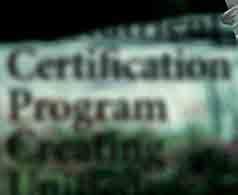

By Dan Toland and Emily Widener
As a soybean farmer, you’re a steward of the environment.
From the elds you plow to the crops you grow, you impact the land and water around you. As an Ohio soybean farmer, your impact travels along the current of the Ohio River, from Pennsylvania to the Mighty Mississippi and to the shores of Lake Erie, from Michigan to New York. Your impact is vital to Ohio’s water quality.
“Many variables affect the quality of Ohio’s waterways, not just agriculture. From industrial pollution and urban storm runo to private septic systems and municipal waste from failed sewer systems, they all take a toll on water
quality,” said John Motter, Ohio Soybean Council (OSC) board member and soybean farmer from Hancock County who also serves on the 4R Advisory Committee & Nutrient Stewardship Council. “While farmers can’t control any of these factors, they can work to improve that of fertilizer runo , an issue that hits close to home for many Ohio farmers.”
e current issue at-hand involves nutrients from farmland, like phosphorous, entering Ohio’s waterways. How much and why are still largely unknown, making farmers’ e orts to proactively alleviate the problem that much more important. But with a late start in the elds this spring and harvest just on the horizon, farmers value every minute of
every day.
at’s why it’s important that those who work hand-in-hand with you on your farm, such as agricultural retailers and nutrient service providers, are wellversed and educated, and continually improving their e orts to better serve you, your customers and the natural resources we all use and enjoy.
Agricultural retailers and nutrient service providers in the Western Lake Erie Basin are now being encouraged to join in a uni ed, comprehensive and responsible approach to nutrient management aimed at the long-term improvement of Lake Erie’s water quality through the new 4R Nutrient Stewardship Certi cation Program.
e 4R approach — using the Right
Nutrient Source at the Right Rate and Right Time in the Right Place — serves as the science-based guideline for the new certi cation program, which is administered by the Ohio AgriBusiness Association (OABA) on behalf of the Nutrient Stewardship Council, a diverse set of stakeholders from business, government, university and non-governmental sectors with a common goal of maintaining agricultural productivity while also improving the quality of Lake Erie and its contributing watersheds.
According to the Nutrient Stewardship Council, Lake Erie is a source of drinking water for millions, home to more than half the sh in the Great Lakes and a draw for tourists. Harmful algal blooms in Lake Erie and other bodies of water have been on the rise the past ve years, leading to increased water treatment costs and negative impacts on shing and tourism
“The program has several features that will make it very e ective in reducing the problems with algae blooms in Lake Erie,” said Bill Stanley, assistant director of e Nature Conservancy in Ohio and a member of the Nutrient Stewardship Advisory Committee. “Most important are a set of scienti cally rigorous standards developed with industry and academic involvement, as well as independent, third-party audits to ensure that those standards are followed.”
of non-governmental organizations, government, farmers and industry folks provide advice and input on the program, speci cally on the auditable criteria.
Officially launched March 18, the new program provides a consistent, recognized standard for agricultural retailers to adopt proven best practices in Indiana, Michigan and Ohio, where surrounding waters drain into Lake Erie.
“As ag retailers, we have to be proactive in nding ways to improve water quality, and the 4R certi cation is a tool that will pay off in a big way,” said John Oster, with Morral Companies, an ag retailer in Morral, Ohio, which served as a partner in piloting the program. “We believe that by enacting this, we will become part of the solution, and we know we can x our part and make things better.”
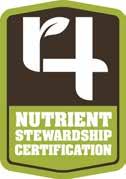
e rst phase of the 4R Nutrient Stewardship Certi cation Program will begin this summer with signups and launch of a threeyear focus on initial training and ongoing education, monitoring of 4R implementation and nutrient recommendations and application.

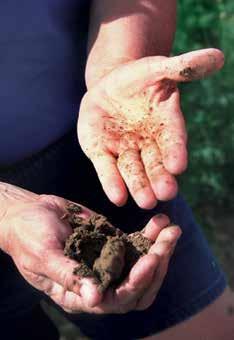
tion communities in the Lake Erie basin, we think we have found some solutions that will achieve lasting conservation, because it is good business for farmers and for Lake Erie,” Vollmer-Sanders said in her blog posted on the White House website in conjunction with the award.
e Nutrient Stewardship Advisory Committee is the original steering committee for the project. e diverse group
e program has already received high-level recognition, as Carrie VolmerSanders, the Western Lake Erie Project Direct for e Nature Conservancy and chair of the Nutrient Stewardship Council was recently honored as a Next Generation of Conservation Leaders Champion of Change by the White House.
“With the teamwork of the agricultural, government, research and conserva-
The 4R Nutrient Certi cation Stewardship Certi cation Program was created to address the following goals:
• Maximize crop uptake of nutrients and minimize nutrient loss
• Create long-term positive impacts on water bodies associated with agricultural production areas
• Encourage sharing of the most up-to-date information about responsible nutrient stewardship with Nutrient Service Providers and growers
• Help the agriculture sector adapt to new research and technology in the area of nutrient stewardship
While individual farmers aren’t included under the scope of the standard, Ohio AgriBusiness Association President and CEO Chris Henney said it’s critical they work in concert with agricultural retailers to adopt best practices to realize long-term improvements. “We’re excited about the initial interest in the program, and encourage those interested to check out our website and commit to participate.”
Ohio soybean farmers should talk to their agricultural retailers and nutrient service providers about the new 4R Nutrient Stewardship Certi cation Program, express a desire to implement best 4R practices, and encourage them to join the e ort to improve the waters we all use and enjoy.
While we can’t control all the contributors to our water quality issues, we all have an opportunity to contribute to its solutions.
For complete program information, requirements and to register, visit 4Rcerti ed.org or contact OABA at info@oaba.net or call 614-326-7520. u



Ohio Soybean Council to Sponsor 2014 Ohio State Fair
By Katie Bauer
The 2014 Ohio State Fair will begin on July 23rd and throughout the twelve day event, fairgoers will have the opportunity to learn about soybeans and soybean farmers thanks to the Ohio Soybean Council (OSC) and soybean checko .
OSC is excited to be one of the presenting sponsors of the Ohio State Fair, 2014 Junior Livestock Shows, Rabbit & Poultry Pavilion, Voinovich Livestock & Trade Center and the O’Neill Swine Building.
Additionally, OSC will host the third annual Ohio Soybean Day at the fair on Saturday, August 2nd. On Soybean Day, OSC will exhibit at the Cardinal Gate on the north side of the fairgrounds where
several OSC board members (all volunteer Ohio soybean farmers) will be available to speak with fairgoers about soybeans and the many uses of the miracle crop.
“We understand that many people are curious about farming today,” said Steve Reinhard, OSC board member and soybean farmer from Crawford County. “One goal during the fair is to provide people with accurate information about soybeans and the markets that are supported by soybean products. While there is some misinformation out there about farming and food production, OSC wants to keep families informed about food and farming and how the two are supporting communities, the economy and many aspects of our daily lives.”
In addition, OSC will also be a part
of the Nationwide Donahey Ag & Hort building for the duration of the fair. OSC will incorporate interactive displays and contest give-a-ways that will educate fairgoers of all ages about the bene ts of soybeans and soybean farming. During the 2013 Ohio State Fair, a total of 903,824 walked through the gates making it Ohio’s largest outdoor event and highlight of the summer. On Soybean Day alone, 105,611 people visited the fair throughout the day.
Join us this year at the 2014 Ohio State Fair
All Ohio soybean farmers can gain admission to the fair free of charge on Soybean Day with the coupon below. With the same coupon, family members will be admitted at a discounted price. u
Saturday, August 2nd, 2014
This voucher allows one FREE admission per household to an Ohio soybean farmer or an Ohio Soybean Association member, and $4 admission to each family member in their party on Ohio Soybean Day at the Fair, Saturday, August 2nd, 2014.



Investing Checkoff Dollars



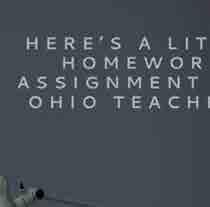








Investing Checkoff Dollars


Exploring the Potential for Private Investment in Locks and Dams

By Mike Steenhoek Executive Director of the Soy Transportation Coalition
America’s inland waterway system, including the network of locks and dams, has been and continues to be a major contributor to the pro tability and competitiveness of the U.S. soybean farmer. For U.S. agriculture, the nation’s navigable waterways are unique not because of their ability to accommodate commercial traffic, but rather due to their close proximity to the most productive farm ground in the world. While other countries have navigable waterways, they are o en far removed from those regions most accountable for agricultural production. In the United States, these waterways are very accessible to a high percentage of the nation’s agricultural production, thereby allowing farmers to connect with international customers in a cost e ective and reliable manner.

the inland waterway system to the success of the American soybean farmer, and the broader economy, the condition of the nation’s locks and dams continues to degrade due to repeated and persistent underinvestment from the federal government. As a result, a recent study funded by the soybean checko explores the potential for engaging and accessing private funding to enhance the condition of the inland waterway system.
Despite the recognized importance of
“Given the continued lack of federal resources toward our lock and dam system, more attention is being devoted to alternative sources of funding, including private equity,” says Patrick Knouff, soybean farmer from Minster, Ohio, chairman of the Soy Transportation Coalition and chairman of the Ohio Soybean Council. “While there is substantial interest in this concept, there is little understanding in how it could work. e
goal of this report is to increase the awareness of both the potential advantages and shortcomings of such an approach. As we proceed toward possibly accessing private investment for our locks and dams, we need to make sure we have our eyes wide open.”


The study, “Proposed Public-Private Partnership Projects for U.S. Inland Waterways Infrastructure Financing, Operations, and Governance,” was performed by e Horinko Group. e analysis provides an introduction to the concept of public-private partnerships, suggests locations that would be likely sites for such an approach, and highlights successful public-private partnerships (P3) in other industries that could serve as a model for the inland waterway system.
A P3 is a contractual agreement between a public sector agency and a private sector entity to deliver a public service. In a future P3, a non-federal entity, either one or more private entities or a public authority, could assume responsibility for the funding, operation and maintenance, replacement, and/or major rehabilitation


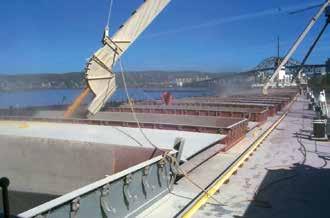

of the locks and dams under a cooperative agreement. e Army Corps of Engineers is the agency with jurisdiction over the lock and dam system and would therefore be the federal partner in a P3 agreement. e research recommends that the U.S. government, under the jurisdiction of the Army Corps of Engineers, would retain ownership of any lock and dam site under a P3 arrangement.
e analysis suggests that under a P3 arrangement, the private sector would likely not have the appetite for investing in the construction of new lock and dam facilities. e more likely approach, according to the report, would be for private investment being devoted to proper maintenance of existing sites.




may be appealing due to their high volume of barge traffic along with comparatively lower maintenance costs required in the immediate future.
It is widely accepted and anticipated that the nal version of the Water Resources Development Act will authorize the establishment of a series of pilot projects to examine the feasibility of a P3 approach to the inland waterways system. Congressional negotiators are currentlynalizing the legislation. It is expected to be considered and passed by both the House of Representatives and the Senate and signed by the President in May or June.

e Soy Transportation Coalition continues to argue that a predictably good inland waterway system is better than a hypothetically great one. Given the reality
that the cost of one lock construction project ($376.8 million) is approximately equal to the cost of nine major rehabilitation projects ($40.7 million each), the Soy Transportation Coalition concurs with the recommendation that a P3 project focused on maintenance is more viable that one premised on new construction. Just because you open the door for private investment does not mean private investment will want to walk through that door. e investment opportunity must be attractive. Emphasizing maintenance of lock and dam sites over new construction will make this investment opportunity more appealing to the private sector. e analysis highlights two possible sites for a P3 pilot project – Peoria and LaGrange locks and dams on the Illinois River and Locks and Dams 24, 25, 26 (Melvin Price Locks and Dam), and 27 on the Upper Mississippi River. e lock and dam sites at Peoria and LaGrange may be appealing due to their location exclusively within the state of Illinois, which could result in a more streamlined and efficient administrative process. e four lock and dam sites on the Upper Mississippi River
A public-private partnership approach for locks and dams could be appealing because of the potential for better project execution and delivery. e private sector o en is better able and equipped to deliver the same or elevated services at a lower cost. e Soy Transportation Coalition believes it is appropriate to examine and investigate alternative methods to nance, operate, maintain, and enhance our inland waterway system. We hope this analysis and soybean farmers in general can play a constructive role in this important discussion.
e full results of the study can be accessed at www.soytransportation.org or www.unitedsoybean.org. u




Investing Checkoff Dollars

Palmer Amaranth: A New Threat

Both waterhemp and Palmer amaranth are highly variable in appearance. While there are differences in vegetative characteristics, these traits are not completely reliable due to the diversity within both species. Because of this, it is important to become familiar with the floral characteristics of both species.


SPINY AMARANTH
Plants have long (up to 1/2"), sharp spines at nodes on the stem. These spines are sometimes mistaken for the sharp bracts on female Palmer amaranth infloresences.

VEGETATIVE TRAITS
REPRODUCTIVE TRAITS
Both species are dioecious, having separate male and female plants.
The inflorescences of both species are highly variable.


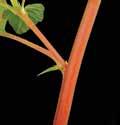


• Rounded leaves


• Some leaves may have petioles longer than leaf blade
• Dense cluster of leaves at top of canopy
Palmer amaranth (A) generally have long terminal branches greater than a half inch in diameter.

Palmer amaranth is native to the southwest U.S., but recently has moved into the Soybean Belt. Compared with native pigweeds (Amaranthus species), Palmer amaranth poses unique management challenges. Therefore, preventing its spread into new areas is important. This document will help you differentiate Palmer amaranth from other pigweed species.
DOES THE PIGWEED HAVE A HAIRY STEM?


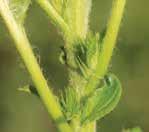


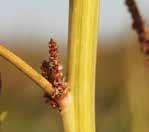




• Elongated leaves
• Open canopy




Most waterhemp (B) have slender branches less than six inches in length; however, some plants produce long branches more than a half inch in diameter.




Female Palmer amaranth flowers (C) have a long (up to 1/2") bract that extends beyond the five tepals and seed capsule. The bracts become sharp at maturity, making female plants painful to handle.










Female waterhemp flowers (D) have a small bract that does not extend beyond the single tepal or seed capsule. Male plants have a short bract with five tepals.
For more information and links to additional resources, visit www.TakeActionOnWeeds.com








Technical editing for this publication was led by Robert Hartzler, Ph.D., Iowa State University, in partnership with other universities in the soybean-growing regions of the United States. The United Soybean Board does not make any representations or warranties relating to the use of the advice contained herein, and is not liable for the use or misuse of the information provided. Take Action is supported by BASF, Bayer, DuPont, Dow, Monsanto and Syngenta. ©2014 United Soybean Board.





Waterhemp
Palmer amaranth
Spiny amaranth
Redroot pigweed
Smooth pigweed
Powell amaranth
Spine


FARMER SELLS SOYBEANS







ELEVATORS PROCESSORS GRAIN DEALERS
1⁄2 OF 1% OF THE TOTAL SELLING PRICE GOES TO THE STATE SOYBEAN BOARD




OHIO SOYBEAN COUNCIL


Led by 18 farmer-leaders, the Ohio Soybean Council works to IMPROVE SOYBEAN PROFITABILITY for all Ohio soybean farmers.















Source: Texas A&M 2009 AND THOSE FUNDS GO TO HALF OF THOSE FUNDS STAY WITH THE








RESEARCH MARKETING EDUCATION AND THE OTHER HALF GOES TO THE NATIONAL


Led by 69 volunteer soybean farmers, the United Soybean Board (USB) invests and leverages soy checkoff dollars to MAXIMIZE PROFIT OPPORTUNITIES U.S. soybean farmers. for all











